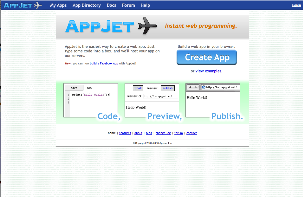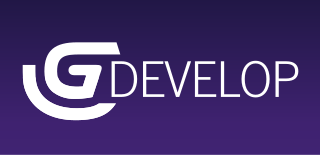In computing, cross-platform software is computer software that is designed to work in several computing platforms. Some cross-platform software requires a separate build for each platform, but some can be directly run on any platform without special preparation, being written in an interpreted language or compiled to portable bytecode for which the interpreters or run-time packages are common or standard components of all supported platforms.

In computing, a visual programming language, also known as diagrammatic programming, graphical programming or block coding, is a programming language that lets users create programs by manipulating program elements graphically rather than by specifying them textually. A VPL allows programming with visual expressions, spatial arrangements of text and graphic symbols, used either as elements of syntax or secondary notation. For example, many VPLs are based on the idea of "boxes and arrows", where boxes or other screen objects are treated as entities, connected by arrows, lines or arcs which represent relations. VPLs are generally the basis of Low-code development platforms.
StarLogo is an agent-based simulation language developed by Mitchel Resnick, Eric Klopfer, and others at the Massachusetts Institute of Technology (MIT) Media Lab and Scheller Teacher Education Program in Massachusetts. It is an extension of the Logo programming language, a dialect of Lisp. Designed for education, StarLogo can be used by students to model or simulate the behavior of decentralized systems.

Scratch is a high-level, block-based visual programming language and website aimed primarily at children as an educational tool, with a target audience of ages 8 to 16. Users on the site can create projects on the website using a block-like interface. Scratch was conceived and designed through collaborative National Science Foundation grants awarded to Mitchel Resnick and Yasmin Kafai. Scratch is developed by the MIT Media Lab and has been translated into 70+ languages, being used in most parts of the world. Scratch is taught and used in after-school centers, schools, and colleges, as well as other public knowledge institutions. As of 15 February 2023, community statistics on the language's official website show more than 123 million projects shared by over 103 million users, over 804 million total projects ever created, and more than 95 million monthly website visits.

AppJet, Inc. was a website that allowed users to create web-based applications on a client web browser. AppJet was founded by three MIT graduates, two of whom were engineers at Google, before starting AppJet. They launched their initial public beta on December 12, 2007, allowing anyone to create a web app.

In computing, a script is a relatively short and simple set of instructions that typically automate an otherwise manual process. The act of writing a script is called scripting. Scripting language or script language describes a programming language that it is used for a script.

MIT App Inventor is a high-level block-based visual programming language, originally built by Google and now maintained by the Massachusetts Institute of Technology. It allows newcomers to create computer applications for two operating systems: Android and iOS, which, as of 25 September 2023, is in beta testing. It is free and open-source released under dual licensing: a Creative Commons Attribution ShareAlike 3.0 Unported license and an Apache License 2.0 for the source code. Its target is primarily children and students studying computer programming, similar to Scratch.

Google Apps Script is a scripting platform developed by Google for light-weight application development in the Google Workspace platform. Google Apps Script was initially developed by Mike Harm as a side project while working as a developer on Google Sheets.

Snap! is a free block-based educational graphical programming language and online community. Snap allows students to explore, create, and remix interactive animations, games, stories, and more, while learning about mathematical and computational ideas. While inspired by Scratch, Snap! has many advanced features. The Snap! editor, and programs created in it, are web applications that run in the browser without requiring installation. It is built on top of Morphic.js, a Morphic GUI, written by Jens Mönig as 'middle layer' between Snap! itself and 'bare' JavaScript.
Google APIs are application programming interfaces (APIs) developed by Google which allow communication with Google Services and their integration to other services. Examples of these include Search, Gmail, Translate or Google Maps. Third-party apps can use these APIs to take advantage of or extend the functionality of the existing services.

Flowgorithm is a graphical authoring tool which allows users to write and execute programs using flowcharts. The approach is designed to emphasize the algorithm rather than the syntax of a specific programming language. The flowchart can be converted to several major programming languages. Flowgorithm was created at Sacramento State University.

Visual Studio Code, also commonly referred to as VS Code, is a source-code editor developed by Microsoft for Windows, Linux, macOS and web browsers. Features include support for debugging, syntax highlighting, intelligent code completion, snippets, code refactoring, and embedded version control with Git. Users can change the theme, keyboard shortcuts, preferences, and install extensions that add functionality.
ASU VIPLE is a Visual IoT/Robotics Programming Language Environment developed at Arizona State University.
ASP.NET Web Forms is a web application framework and one of several programming models supported by the Microsoft ASP.NET technology. Web Forms applications can be written in any programming language which supports the Common Language Runtime, such as C# or Visual Basic. The main building blocks of Web Forms pages are server controls, which are reusable components responsible for rendering HTML markup and responding to events. A technique called view state is used to persist the state of server controls between normally stateless HTTP requests.
Google App Maker was a low-code application development tool, developed by Google Inc. as part of the G Suite family. It allowed developers or its users to build and deploy custom business apps on the web.

GDevelop is a 2D and 3D cross-platform, free and open-source game engine, which mainly focuses on creating PC and mobile games, as well as HTML5 games playable in the browser. Created by Florian Rival, a software engineer at Google, GDevelop is mainly aimed at non-programmers and game developers of all skillsets, employing event based visual programming similar to engines like Construct, Stencyl, and Tynker.










